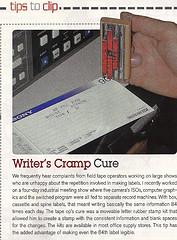 A design team threw up his hands and confronts the fact that the lead model in much more expensive and longer than the mark up on the new. However, such problems do not occur only rarely printing company. Often, even the professionals who know the whole publishing process, as the picture on the mat mice are not immune from a simple lack of some fonts. The following is to make a small digression. A consequence of the presence of such problems is the existence of two sets of fonts: TrueType – for office systems, and Type1 (for printing). From the perspective of a simple user is no difference between them: Select the text you selected in the font name, sent a document to the printer and ready. But here's the action taking place between the printer and text editor, in each case differ dramatically, so often in print printing text in TrueType, will not succeed.
A design team threw up his hands and confronts the fact that the lead model in much more expensive and longer than the mark up on the new. However, such problems do not occur only rarely printing company. Often, even the professionals who know the whole publishing process, as the picture on the mat mice are not immune from a simple lack of some fonts. The following is to make a small digression. A consequence of the presence of such problems is the existence of two sets of fonts: TrueType – for office systems, and Type1 (for printing). From the perspective of a simple user is no difference between them: Select the text you selected in the font name, sent a document to the printer and ready. But here's the action taking place between the printer and text editor, in each case differ dramatically, so often in print printing text in TrueType, will not succeed.
Even cross-platform PDF-file does not help here: TrueType typeface just porushat the entire file. It seems there is no problem, sort of like enough to buy and install Type1, and you can safely do layout. But the problem is that these products are designed for printing and publishing, so their sets are expensive. and what do those small businesses and entrepreneurs, just who can not afford to pay big bucks for desktop publishing, and print a leaflet really want? What can be done in printing for beginners who know function 'Create Booklet' in MS Word, but are unable to or unwilling to understand the subtleties of prepress? Fairly good option is to use a converter box. It allows you to finally merge the two realities into one. It's simple – you 'print' to impose a booklet on the virtual printer and the result is a file that is stored exactly your registration. Incidentally, PDF, obtained in this way, 'will understand' TrueType, since the document placed in a raster image, which parameters can be set so that the print quality will not differ from that obtained in the traditional way. No matter what the hidden features of training you do not take into account – your brochure will always look the way you want.
 Entry to conduct business in the Netherlands – the Netherlands implies a conclusion of commercial contracts. While you are free to legally enter into contracts in the Netherlands –
Entry to conduct business in the Netherlands – the Netherlands implies a conclusion of commercial contracts. While you are free to legally enter into contracts in the Netherlands –  French Manicure – a short cropped nails natural colors (beige, pale pink) with white edge. Naturalness plays a major role. In this case the nails are beautiful stylish appearance, practical in everyday life and are the choice of business women, due to its advantages, which are as follows: for the daily care enough to cover your nails with clear lacquer finish, they will always look fresh and neat, and if to be a business meeting or a glamorous party, it will be enough to put on the edge of a small bar in the form of silver paint or decorate the surface of the nail or small crystals risunkom.Na fact, you can use your fantasy, what ever you want. You can experiment with different contrasting colors for painting the edge of the nail plate itself. Today, you can buy a lot of different labels that perfectly decorate your nogti.Mnogie women believe that a French manicure done at home is difficult or impossible.
French Manicure – a short cropped nails natural colors (beige, pale pink) with white edge. Naturalness plays a major role. In this case the nails are beautiful stylish appearance, practical in everyday life and are the choice of business women, due to its advantages, which are as follows: for the daily care enough to cover your nails with clear lacquer finish, they will always look fresh and neat, and if to be a business meeting or a glamorous party, it will be enough to put on the edge of a small bar in the form of silver paint or decorate the surface of the nail or small crystals risunkom.Na fact, you can use your fantasy, what ever you want. You can experiment with different contrasting colors for painting the edge of the nail plate itself. Today, you can buy a lot of different labels that perfectly decorate your nogti.Mnogie women believe that a French manicure done at home is difficult or impossible.